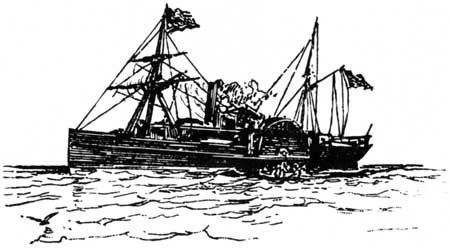|
FORT SUMTER National Monument |
 |

The Star of the West.
From
Battles and Leaders of the Civil War.
The Star of the
West
President Buchanan was persuaded to send off a relief expedition almost immediately. Initial plans called for the dispatch of the sloop of war Brooklyn for this purpose, but when word came which indicated that the South Carolinians had obstructed the harbor entrance by sinking several ships, it was decided to use an ordinary merchant ship. The Brooklyn, of heavy draft, could probably not now pass into the harbor. A merchant ship would certainly excite less suspicion and would avoid the appearance of a coercive movement. Accordingly, the Star of the West—a ship which regularly sailed southward from New York—was chartered. Two hundred men, small arms and ammunition, and several months' provisions were placed aboard. The men were to remain below deck on entering Charleston Harbor; the Brooklyn would follow, in case the Star of the West were fired upon and disabled.
But Charleston was forewarned. When the Star of the West appeared at the entrance of the harbor on January 9, 1861, Citadel cadets opened fire with a gun mounted on Cummings Point; and the merchant ship, unarmed, steamed out of the harbor. Anderson had held his fire, thinking the firing unauthorized by the State authorities. Orders authorizing supporting fire on his part had failed to reach him in time. As if accidentally, civil war had been averted for the moment.
There was some Northern reaction to the incident, but further plans for Anderson's relief once projected, were delayed. Anderson indicated no immediate need, and President Buchanan was anxious to end his term of office in peace. On January 10, the Secretary of War had ordered Major Anderson to act "strictly on the defensive." Anderson and Governor Pickens of South Carolina exchanged angry letters, and the Governor's demand for the fort's surrender (January 11) was resolved in the "mission" to Washington of the State's attorney general, I. G. Hayne. When that mission, tempered by the efforts of cooler-headed Southern Senators, met stubborn resistance on the part of President Buchanan, the situation was resolved in the formation of the Southern Confederacy, with the consequent assumption of the Fort Sumter problem by that government.

|
|
Last Modified: Mon, Dec 2 2002 10:00:00 am PDT |


